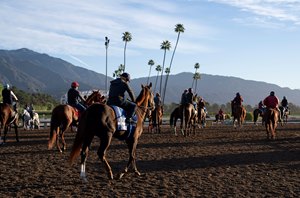'More Work to be Done' on Equine Shoulder Fractures


Horse racing has seen sharp declines in most types of equine musculoskeletal fatalities, but reductions to one particular type of injury— the shoulder fracture—have been less dramatic.
Speaking before the California Horse Racing Board May 15, CHRB equine medical director Dr. Jeff Blea noted that the four musculoskeletal fatalities that occurred last month at California racetracks were all shoulder fractures, bringing the total of shoulder fatalities this year to six, based on his announced figures. The CHRB website still lists "pending" as the cause of death for the state's three most recent musculoskeletal fatalities.
California conducts some of the safest racing in the nation and has been a leader in numerous equine welfare advances.
Asked Thursday by CHRB chair Dr. Greg Ferraro about what more can be done to address such injuries, Blea replied, "I do think we are getting somewhere. It's just slow."
Shoulder fractures involve the scapula (shoulder blade) or the humerus (upper arm bone). He said the state has averaged about 10 shoulder fatalities per year in recent years, down from the 13 1/2 average that had been the state's norm. The fractures typically occur due to bone weakening associated with a pre-existing stress fracture.
"So I think an increased awareness is important," Blea said.
Blea said training soundness examinations have been effective in spotting horses at risk. He noted that the majority of shoulder injury fatalities are humeral and typically involve horses returning from layoffs. Of the four musculoskeletal fatalities in California last month, three involved horses returning from time away from racing, and the other horse was unraced.
According to the University of California Davis School of Veterinary Medicine, a humeral stress fracture should be considered if a horse shows poor action or transitory lameness, especially during a return to training. Some return-to-training injuries can be attributed in part to rehabilitation that unloads the skeleton, and bones experiencing high increases in load with a resumption of activity.
Stress fractures can be reliably detected using a bone scan. Identified horses can often recover and return to racing.
Two weeks ago, the CHRB sent out a memorandum to encourage horsemen to review continuing education modules related to shoulder fractures to assist in understanding and prevention of such injuries. The CHRB provides a link to continuing education modules on its website.
"These (shoulder fracture figures) seem to be constant, if somewhat of a declining slope. But there is still more work to be done with these," Blea said.
